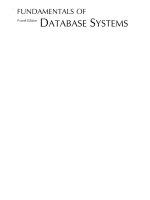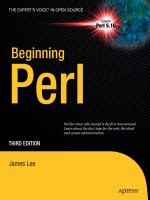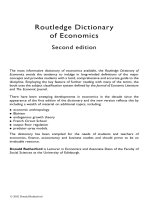Java Concepts 5th Edition phần 1 potx
Bạn đang xem bản rút gọn của tài liệu. Xem và tải ngay bản đầy đủ của tài liệu tại đây (1.87 MB, 112 trang )
Java Concepts, 5th Edition
Java Concepts Page 1 of 4
Java Concepts, 5th Edition
Java Concepts
FIFTH EDITION
Cay Horstmann
SAN JOSE STATE UNIVERSITY
John Wiley & Sons, Inc.
978-0-470-10555-9
Java Concepts Page 2 of 4
Java Concepts, 5th Edition
Chapter 1 Introduction
Chapter 2 Using Objects
Chapter 3 Implementing Classes
Chapter 4 Fundamental Data Types
Chapter 5 Decisions
Chapter 6 Iteration
Chapter 7 Arrays and Array Lists
Chapter 8 Designing Classes
Chapter 9 Interfaces and Polymorphism
Chapter 10 Inheritance
Chapter 11 Input/Output and Exception Handling
Chapter 12 Object-Oriented Design
Chapter 13 Recursion
Chapter 14 Sorting and Searching
Chapter 15 An Introduction to Data Structures
Chapter 16 Advanced Data Structures
Chapter 17 Generic Programming
1
1
226
226
586
586
626
626
764
Java Concepts Page 3 of 4
Java Concepts, 5th Edition
Chapter 18 Graphical User Interfaces
Java Concepts Page 4 of 4
Java Concepts, 5th Edition
Chapter 1 Introduction
CHAPTER GOALS
• To understand the activity of programming
• To learn about the architecture of computers
• To learn about machine code and high-level programming languages
• To become familiar with your computing environment and your compiler
• To compile and run your first Java program
• To recognize syntax and logic errors
The purpose of this chapter is to familiarize you with the concept of programming. It
reviews the architecture of a computer and discusses the difference between machine
code and high-level programming languages. Finally, you will see how to compile
and run your first Java program, and how to diagnose errors that may occur when a
program is compiled or executed.
1.1 What Is Programming?
You have probably used a computer for work or fun. Many people use computers for
everyday tasks such as balancing a checkbook or writing a term paper. Computers are
good for such tasks. They can handle repetitive chores, such as totaling up numbers or
placing words on a page, without getting bored or exhausted. Computers also make
good game machines because they can play sequences of sounds and pictures,
involving the human user in the process.
The flexibility of a computer is quite an amazing phenomenon. The same machine can
balance your checkbook, print your term paper, and play a game. In contrast, other
machines carry out a much narrower range of tasks—a car drives and a toaster toasts.
To achieve this flexibility, the computer must be programmed to perform each task. A
computer itself is a machine that stores data (numbers, words, pictures), interacts with
devices (the monitor screen, the sound system, the printer), and executes programs.
2
Chapter 1 Introduction Page 1 of 43
Java Concepts, 5th Edition
Programs are sequences of instructions and decisions that the computer carries out to
achieve a task. One program balances checkbooks; a different program, perhaps
designed and constructed by a different company, processes words; and a third
program, probably from yet another company, plays a game.
A computer must be programmed to perform tasks. Different tasks require different
programs.
Today's computer programs are so sophisticated that it is hard to believe that they are
all composed of extremely primitive operations.
A computer program executes a sequence of very basic operations in rapid
succession.
A typical operation may be one of the following:
• Put a red dot onto this screen position.
• Send the letter A to the printer.
• Get a number from this location in memory.
• Add up two numbers.
• If this value is negative, continue the program at that instruction.
A computer program tells a computer, in minute detail, the sequence of steps that are
needed to complete a task. A program contains a huge number of simple operations,
and the computer executes them at great speed. The computer has no intelligence—it
simply executes instruction sequences that have been prepared in advance.
A computer program contains the instruction sequences for all tasks that it can
execute.
To use a computer, no knowledge of programming is required. When you write a term
paper with a word processor, that software package has been programmed by the
manufacturer and is ready for you to use. That is only to be expected—you can drive a
car without being a mechanic and toast bread without being an electrician.
2
3
Chapter 1 Introduction Page 2 of 43
Java Concepts, 5th Edition
A primary purpose of this book is to teach you how to design and implement computer
programs. You will learn how to formulate instructions for all tasks that your programs
need to execute.
Keep in mind that programming a sophisticated computer game or word processor
requires a team of many highly skilled programmers, graphic artists, and other
professionals. Your first programming efforts will be more mundane. The concepts
and skills you learn in this book form an important foundation, but you should not
expect to immediately produce professional software. A typical college program in
computer science or software engineering takes four years to complete; this book is
intended as an introductory course in such a program.
Many students find that there is an immense thrill even in simple programming tasks.
It is an amazing experience to see the computer carry out a task precisely and quickly
that would take you hours of drudgery.
SELF CHECK
1. What is required to play a music CD on a computer?
2. Why is a CD player less flexible than a computer?
3. Can a computer program develop the initiative to execute tasks in a better
way than its programmers envisioned?
1.2 The Anatomy of a Computer
To understand the programming process, you need to have a rudimentary
understanding of the building blocks that make up a computer. This section will
describe a personal computer. Larger computers have faster, larger, or more powerful
components, but they have fundamentally the same design.
3
Chapter 1 Introduction Page 3 of 43
Java Concepts, 5th Edition
Figure 1
Central Processing Unit
At the heart of the computer lies the central processing unit (CPU) (see Figure 1). It
consists of a single chip (integrated circuit) or a small number of chips. A computer
chip is a component with a plastic or metal housing, metal connectors, and inside
wiring made principally from silicon. For a CPU chip, the inside wiring is enormously
complicated. For example, the Pentium 4 chip (a popular CPU for personal computers
at the time of this writing) contains over 50 million structural elements called
transistors—the elements that enable electrical signals to control other electrical
signals, making automatic computing possible. The CPU locates and executes the
program instructions; it carries out arithmetic operations such as addition, subtraction,
multiplication, and division; and it fetches data from storage and input/output devices
and sends data back.
At the heart of the computer lies the central processing unit (CPU).
The computer keeps data and programs in storage. There are two kinds of storage.
Primary storage, also called random-access memory (RAM) or simply memory, is fast
but expensive; it is made from memory chips (see Figure 2). Primary storage has two
disadvantages. It is comparatively expensive, and it loses all its data when the power is
turned off. Secondary storage, usually a hard disk (see Figure 3), provides less
3
4
Chapter 1 Introduction Page 4 of 43
Java Concepts, 5th Edition
expensive storage that persists without electricity. A hard disk consists of rotating
platters, which are coated with a magnetic material, and read/write heads, which can
detect and change the patterns of varying magnetic flux on the platters. This is
essentially the same recording and playback process that is used in audio or video
tapes.
Data and programs are stored in primary storage (memory) and secondary storage
(such as a hard disk).
Some computers are self-contained units, whereas others are interconnected through
networks. Home computers are usually intermittently connected to the Internet via a
dialup or broadband connection. The computers in your computer lab are probably
permanently connected to a local area network. Through the network cabling, the
computer can read programs from central storage locations or send data to other
computers. For the user of a networked computer, it may not even be obvious which
data reside on the computer itself and which are transmitted through the network.
Figure 2
A Memory Module with Memory Chips
Most computers have removable storage devices that can access data or programs on
media such as floppy disks, tapes, or compact discs (CDs).
4
5
Chapter 1 Introduction Page 5 of 43
Java Concepts, 5th Edition
Figure 3
A Hard Disk.
5
Chapter 1 Introduction Page 6 of 43
Java Concepts, 5th Edition
Figure 4
A Motherboard
To interact with a human user, a computer requires other peripheral devices. The
computer transmits information to the user through a display screen, loudspeakers, and
printers. The user can enter information and directions to the computer by using a
keyboard or a pointing device such as a mouse.
The CPU, the RAM, and the electronics controlling the hard disk and other devices are
interconnected through a set of electrical lines called a bus. Data travel along the bus
from the system memory and peripheral devices to the CPU and back. Figure 4 shows
a motherboard, which contains the CPU, the RAM, and connectors to peripheral
devices.
Figure 5 gives a schematic overview of the architecture of a computer. Program
instructions and data (such as text, numbers, audio, or video) are stored on the hard
disk, on a CD, or on a network. When a program is started, it is brought into memory
where it can be read by the CPU. The CPU reads the program one instruction at a time.
As directed by these instructions, the CPU reads data, modifies it, and writes it back to
RAM or to secondary storage. Some program instructions will cause the CPU to
5
6
Chapter 1 Introduction Page 7 of 43
Java Concepts, 5th Edition
interact with the devices that control the display screen or the speaker. Because these
actions happen many times over and at great speed, the human user will perceive
images and sound. Similarly, the CPU can send instructions to a printer to mark the
paper with patterns of closely spaced dots, which a human recognizes as text
characters and pictures. Some program instructions read user input from the keyboard
or mouse. The program analyzes the nature of these inputs and then executes the next
appropriate instructions.
The CPU reads machine instructions from memory. The instructions direct it to
communicate with memory, secondary storage, and peripheral devices.
Figure 5
Schematic Diagram of a Computer
SELF CHECK
4. Where is a program stored when it is not currently running?
5. Which part of the computer carries out arithmetic operations, such as
addition and multiplication?
6
7
Chapter 1 Introduction Page 8 of 43
Java Concepts, 5th Edition
RANDOM FACT 1.1: The ENIAC and the Dawn of
Computing
The ENIAC (electronic numerical integrator and computer) was the first usable
electronic computer. It was designed by J. Presper Eckert and John Mauchly at the
University of Pennsylvania and was completed in 1946. Instead of transistors,
which were not invented until two years after it was built, the ENIAC contained
about 18,000 vacuum tubes in many cabinets housed in a large room (see The
ENIAC figure). Vacuum tubes burned out at the rate of several tubes per day. An
attendant with a shopping cart full of tubes constantly made the rounds and replaced
defective ones. The computer was programmed by connecting wires on panels.
Each wiring configuration would set up the computer for a particular problem. To
have the computer work on a different problem, the wires had to be replugged.
Work on the ENIAC was supported by the U.S. Navy, which was interested in
computations of ballistic tables that would give the trajectory of a projectile,
depending on the wind resistance, initial velocity, and atmospheric conditions. To
compute the trajectories, one must find the numerical solutions of certain
differential equations; hence the name “numerical integrator”. Before machines like
ENIAC were developed, humans did this kind of work, and until the 1950s the
word “computer” referred to these people. The ENIAC was later used for peaceful
purposes, such as the tabulation of U.S. census data.
The ENIAC
7
8
Chapter 1 Introduction Page 9 of 43
Java Concepts, 5th Edition
1.3 Translating Human-Readable Programs to Machine
Code
On the most basic level, computer instructions are extremely primitive. The processor
executes machine instructions. CPUs from different vendors, such as the Intel Pentium
or the Sun SPARC, have different sets of machine instructions. To enable Java
applications to run on multiple CPUs without modification, Java programs contain
machine instructions for a so-called “Java virtual machine” (JVM), an idealized CPU
that is simulated by a program run on the actual CPU. The difference between actual
and virtual machine instructions is not important—all you need to know is that
machine instructions are very simple, are encoded as numbers and stored in memory,
and can be executed very quickly.
Generally, machine code depends on the CPU type. However, the instruction set of
the Java virtual machine (JVM) can be executed on many CPUs.
A typical sequence of machine instructions is
1. Load the contents of memory location 40.
2. Load the value 100.
3. If the first value is greater than the second value, continue with the instruction
that is stored in memory location 240.
Actually, machine instructions are encoded as numbers so that they can be stored in
memory. On the Java virtual machine, this sequence of instruction is encoded as the
sequence of numbers
21 40
16 100
163 240
When the virtual machine fetches this sequence of numbers, it decodes them and
executes the associated sequence of commands.
How can you communicate the command sequence to the computer? The most direct
method is to place the actual numbers into the computer memory. This is, in fact, how
8
9
Chapter 1 Introduction Page 10 of 43
Java Concepts, 5th Edition
the very earliest computers worked. However, a long program is composed of
thousands of individual commands, and it is tedious and error-prone to look up the
numeric codes for all commands and manually place the codes into memory. As we
said before, computers are really good at automating tedious and error-prone activities,
and it did not take long for computer programmers to realize that computers could be
harnessed to help in the programming process.
Because machine instructions are encoded as numbers, it is difficult to write
programs in machine code.
In the mid-1950s, high-level programming languages began to appear. In these
languages, the programmer expresses the idea behind the task that needs to be
performed, and a special computer program, called a compiler, translates the
high-level description into machine instructions for a particular processor.
High-level languages allow you to describe tasks at a higher conceptual level than
machine code.
For example, in Java, the high-level programming language that you will use in this
book, you might give the following instruction:
if (intRate > 100)
System.out.println("Interest rate error");
This means, “If the interest rate is over 100, display an error message”. It is then the
job of the compiler program to look at the sequence of characters if (intRate >
100) and translate that into
21 40 16 100 163 240 . . .
Compilers are quite sophisticated programs. They translate logical statements, such as
the if statement, into sequences of computations, tests, and jumps. They assign
memory locations for variables—items of information identified by symbolic names—
like intRate. In this course, we will generally take the existence of a compiler for
granted. If you decide to become a professional computer scientist, you may well learn
more about compiler-writing techniques later in your studies.
Chapter 1 Introduction Page 11 of 43
Java Concepts, 5th Edition
A compiler translates programs written in a high-level language into machine code.
SELF CHECK
6. What is the code for the Java virtual machine instruction “Load the
contents of memory location 100”?
7. Does a person who uses a computer for office work ever run a compiler?
1.4 The Java Programming Language
In 1991, a group led by James Gosling and Patrick Naughton at Sun Microsystems
designed a programming language that they code-named “Green” for use in consumer
devices, such as intelligent television “set-top” boxes. The language was designed to
be simple and architecture neutral, so that it could be executed on a variety of
hardware. No customer was ever found for this technology.
Java was originally designed for programming consumer devices, but it was first
successfully used to write Internet applets.
Gosling recounts that in 1994 the team realized, “We could write a really cool
browser. It was one of the few things in the client/server mainstream that needed some
of the weird things we'd done: architecture neutral, real-time, reliable, secure”. Java
was introduced to an enthusiastic crowd at the SunWorld exhibition in 1995.
Since then, Java has grown at a phenomenal rate. Programmers have embraced the
language because it is simpler than its closest rival, C++. In addition, Java has a rich
library that makes it possible to write portable programs that can bypass proprietary
operating systems—a feature that was eagerly sought by those who wanted to be
independent of those proprietary systems and was bitterly fought by their vendors. A
“micro edition” and an “enterprise edition” of the Java library make Java programmers
at home on hardware ranging from smart cards and cell phones to the largest Internet
servers.
9
10
Chapter 1 Introduction Page 12 of 43
Java Concepts, 5th Edition
Java was designed to be safe and portable, benefiting both Internet users and
students.
Because Java was designed for the Internet, it has two attributes that make it very
suitable for beginners: safety and portability. If you visit a web page that contains Java
code (so-called applets—see Figure 6 for an example), the code automatically starts
running. It is important that you can trust that applets are inherently safe. If an applet
could do something evil, such as damaging data or reading personal information on
your computer, then you would be in real danger every time you browsed the Web—
an unscrupulous designer might put up a web page containing dangerous code that
would execute on your machine as soon as you visited the page. The Java language has
an assortment of security features that guarantees that no evil applets can run on your
computer. As an added benefit, these features also help you to learn the language
faster. The Java virtual machine can catch many kinds of beginners' mistakes and
report them accurately. (In contrast, many beginners' mistakes in the C++ language
merely produce programs that act in random and confusing ways.) The other benefit of
Java is portability. The same Java program will run, without change, on Windows,
UNIX, Linux, or the Macintosh. This too is a requirement for applets. When you visit
a web page, the web server that serves up the page contents has no idea what computer
you are using to browse the Web. It simply returns you the portable code that was
generated by the Java compiler. The virtual machine on your computer executes that
portable code. Again, there is a benefit for the student. You do not have to learn how
to write programs for different operating systems.
10
11
Chapter 1 Introduction Page 13 of 43
Java Concepts, 5th Edition
Figure 6
An Applet for Visualizing Molecules ([1])
At this time, Java is firmly established as one of the most important languages for
general-purpose programming as well as for computer science instruction. However,
although Java is a good language for beginners, it is not perfect, for three reasons.
Because Java was not specifically designed for students, no thought was given to
making it really simple to write basic programs. A certain amount of technical
machinery is necessary in Java to write even the simplest programs. This is not a
problem for professional programmers, but it is a drawback for beginning students. As
you learn how to program in Java, there will be times when you will be asked to be
satisfied with a preliminary explanation and wait for complete details in a later chapter.
Chapter 1 Introduction Page 14 of 43
Java Concepts, 5th Edition
Java was revised and extended many times during its life—see Table 1. In this book,
we assume that you have Java version 5 or later.
Finally, you cannot hope to learn all of Java in one semester. The Java language itself
is relatively simple, but Java contains a vast set of library packages that are required to
write useful programs. There are packages for graphics, user interface design,
cryptography, networking, sound, database storage, and many other purposes. Even
expert Java programmers cannot hope to know the contents of all of the packages—
they just use those that they need for particular projects.
Java has a very large library. Focus on learning those parts of the library that you
need for your programming projects.
Using this book, you should expect to learn a good deal about the Java language and
about the most important packages. Keep in mind that the central goal of this book is
not to make you memorize Java minutiae, but to teach you how to think about
programming.
Table 1 Java Versions
Version Year Important New Features
1.0 1996
1.1 1997 Inner classes
1.2 1998 Swing, Collections
1.3 2000 Performance enhancements
1.4 2002 Assertions, XML
5 2004 Generic classes, enhanced for loop, auto-boxing,
enumerations
6 2006 Library improvements
SELF CHECK
8. What are the two most important benefits of the Java language?
9. How long does it take to learn the entire Java library?
11
12
Chapter 1 Introduction Page 15 of 43
Java Concepts, 5th Edition
1.5 Becoming Familiar with Your Computer
You may be taking your first programming course as you read this book, and you may
well be doing your work on an unfamiliar computer system. Spend some time
familiarizing yourself with the computer. Because computer systems vary widely, this
book can only give an outline of the steps you need to follow. Using a new and
unfamiliar computer system can be frustrating, especially if you are on your own.
Look for training courses that your campus offers, or ask a friend to give you a brief
tour.
Set aside some time to become familiar with the computer system and the Java
compiler that you will use for your class work.
Figure 7
A Shell Window
Step 1. Log In
If you use your home computer, you probably don't need to worry about this step.
Computers in a lab, however, are usually not open to everyone. You may need an
account name or number and a password to gain access to such a system.
12
13
Chapter 1 Introduction Page 16 of 43
Java Concepts, 5th Edition
Step 2. Locate the Java Compiler
Figure 8
An Integrated Development Environment
Computer systems differ greatly in this regard. On some systems you must
open a shell window (see Figure 7) and type commands to launch the compiler.
Other systems have an integrated development environment in which you can write
and test your programs (see Figure 8). Many university labs have information sheets
and tutorials that walk you through the tools that are installed in the lab. Instructions
for several popular compilers are available in WileyPLUS.
13
14
Chapter 1 Introduction Page 17 of 43
Java Concepts, 5th Edition
Step 3. Understand Files and Folders
As a programmer, you will write Java programs, try them out, and improve them.
Your programs are kept in files. A file is a collection of items of information that are
kept together, such as the text of a word-processing document or the instructions of a
Java program. Files have names, and the rules for legal names differ from one
system to another. Some systems allow spaces in file names; others don't. Some
distinguish between upper- and lowercase letters; others don't. Most Java compilers
require that Java files end in an extension—.java; for example, Test.java. Java
file names cannot contain spaces, and the distinction between upper- and lowercase
letters is important.
Figure 9
Nested Folders
Chapter 1 Introduction Page 18 of 43
Java Concepts, 5th Edition
Files are stored in folders or directories. These file containers can be nested. That is,
a folder can contain not only files but also other folders, which themselves can
contain more files and folders (see Figure 9). This hierarchy can be quite large,
especially on networked computers, where some of the files may be on your local
disk, others elsewhere on the network. While you need not be concerned with every
branch of the hierarchy, you should familiarize yourself with your local
environment. Different systems have different ways of showing files and directories.
Some use a graphical display and let you move around by clicking the mouse on
folder icons. In other systems, you must enter commands to visit or inspect different
locations.
Step 4. Write a Simple Program
In the next section, we will introduce a very simple program. You will need to learn
how to type it in, how to run it, and how to fix mistakes.
Step 5. Save Your Work
You will spend many hours typing Java program code and improving it. The
resulting program files have some value, and you should treat them as you would
other important property. A conscientious safety strategy is particularly important
for computer files. They are more fragile than paper documents or other more
tangible objects. It is easy to delete a file accidentally, and occasionally files are lost
because of a computer malfunction. Unless you keep a copy, you must then retype
the contents. Because you probably won't remember the entire file, you will likely
find yourself spending almost as much time as you did to enter and improve it in the
first place. This costs time, and it may cause you to miss deadlines. It is therefore
crucial that you learn how to safeguard files and that you get in the habit of doing so
before disaster strikes. You can make safety or backup copies of files by saving
copies on a floppy or CD, into another folder, to your local area network, or on the
Internet.
Develop a strategy for keeping backup copies of your work before disaster strikes.
14
15
Chapter 1 Introduction Page 19 of 43
Java Concepts, 5th Edition
SELF CHECK
10. How are programming projects stored on a computer?
11. What do you do to protect yourself from data loss when you work on
programming projects?
PRODUCTIVITY HINT 1.1: Understand the File System
In recent years, computers have become easier to use for home or office users.
Many inessential details are now hidden from casual users. For example, many
casual users simply place all their work inside a default folder (such as “Home”
or “My Documents”) and are blissfully ignorant about details of the file system.
But you need to know how to impose an organization on the data that you create.
You also need to be able to locate and inspect files that are required for
translating and running Java programs.
If you are not comfortable with files and folders, be sure to set aside some time to
learn about these concepts. Enroll in a short course, or take a web tutorial. Many
free tutorials are available on the Internet, but unfortunately their locations
change frequently. Search the Web for “files and folders tutorial” and pick a
tutorial that goes beyond the basics.
PRODUCTIVITY HINT 1.2: Have a Backup Strategy
Come up with a strategy for your backups now, before you lose any data. Here are
a few pointers to keep in mind.
• Select a backup medium. Floppy disks are the traditional choice, but they
can be unreliable. CD media are more reliable and hold far more
information, but they are more expensive. An increasingly popular form of
backup is Internet file storage. Many people use two levels of backup: a
folder on the hard disk for quick and dirty backups, and a CD-ROM for
higher security. (After all, a hard disk can crash—a particularly common
problem with laptop computers.)
15
16
Chapter 1 Introduction Page 20 of 43
Java Concepts, 5th Edition
• Back up often. Backing up a file takes only a few seconds, and you will
hate yourself if you have to spend many hours recreating work that you
easily could have saved.
• Rotate backups. Use more than one set of disks or folders for backups, and
rotate them. That is, first back up onto the first backup destination, then to
the second and third, and then go back to the first. That way you always
have three recent backups. Even if one of the floppy disks has a defect, or
you messed up one of the backup directories, you can use one of the others.
• Back up source files only. The compiler translates the files that you write
into files consisting of machine code. There is no need to back up the
machine code files, because you can recreate them easily by running the
compiler again. Focus your backup activity on those files that represent
your effort. That way your backups won't fill up with files that you don't
need.
• Pay attention to the backup direction. Backing up involves copying files
from one place to another. It is important that you do this right—that is,
copy from your work location to the backup location. If you do it the wrong
way, you will overwrite a newer file with an older version.
• Check your backups once in a while. Double-check that your backups are
where you think they are. There is nothing more frustrating than finding out
that the backups are not there when you need them. This is particularly true
if you use a backup program that stores files on an unfamiliar device (such
as data tape) or in a compressed format.
• Relax before restoring. When you lose a file and need to restore it from
backup, you are likely to be in an unhappy, nervous state. Take a deep
breath and think through the recovery process before you start. It is not
uncommon for an agitated computer user to wipe out the last backup when
trying to restore a damaged file.
16
Chapter 1 Introduction Page 21 of 43









